Charlestown, Maryland, a town steeped in rich history dating back to its establishment in 1742, offers a captivating glimpse into colonial America. Founded by an Act of the Maryland Assembly to foster trade and navigation in the Chesapeake Bay region, Charlestown quickly became a vital port and taxation hub. Among its many historical treasures, the Wellwood Club, located on Water Street in Charlestown, MD, stands as a testament to the town’s enduring legacy and connection to the water. This article delves into the fascinating history of Charlestown, highlighting landmarks like the Wellwood Club and the significance of Water Street within this historic context.
Charlestown’s origins are rooted in the vision of Maryland’s colonial leaders who sought to establish a thriving port at the head of the Chesapeake Bay. Named in honor of Charles Calvert, the 5th Lord Baron of Baltimore, the town was strategically positioned on Long Point along the North East River in Cecil County. From its inception, Charlestown was designed for commerce, boasting a public wharf and a substantial three-story warehouse to facilitate trade. The appointment of a flour inspector underscores the town’s commitment to quality and its early economic focus on agricultural exports.
 Alt text: The historic Linton House in Charlestown MD, a brick building with a gable roof, representing colonial architecture along the Old Post Road.
Alt text: The historic Linton House in Charlestown MD, a brick building with a gable roof, representing colonial architecture along the Old Post Road.
As Charlestown flourished, it evolved into a major port and a crucial taxation center for the British colony. Its strategic location along the “Old Post Road” further enhanced its importance, connecting it to major urban centers like Baltimore and Philadelphia. Notably, Charlestown served as the county seat for Cecil County from 1782 to 1787, solidifying its political and administrative significance in the region. Today, Charlestown proudly holds the title of the oldest town in Cecil County and the third oldest in the entire state of Maryland, a testament to its long and storied past.
The most prominent chapter in Charlestown’s history unfolded during the colonial period and the immediate aftermath of the Revolutionary War (1742–1790). During the Revolutionary War, Charlestown played a pivotal role as a major supply depot for the Continental Army. Its strategic location and established infrastructure made it an invaluable asset for the American forces.
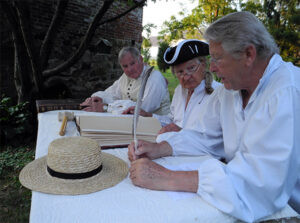 Alt text: Colonial reenactors in Charlestown MD, depicting Revolutionary War soldiers with fife and drum, representing the town’s historical involvement in the American Revolution.
Alt text: Colonial reenactors in Charlestown MD, depicting Revolutionary War soldiers with fife and drum, representing the town’s historical involvement in the American Revolution.
However, Charlestown’s significance extends beyond the Revolutionary War. Even in its earlier days, the town attracted distinguished figures such as Benjamin Franklin, George Washington, and the renowned American artist Charles Willson Peale. George Washington’s diaries record at least two instances where he enjoyed meals and lodging in Charlestown, highlighting its importance as a stopover on the Old Post Road. Other notable residents included John Paca, brother of Declaration of Independence signer William Paca, and George Read, father of another signer, Charles Read, further cementing Charlestown’s connection to the nation’s founding era.
Nathaniel Ramsay, perhaps Charlestown’s most distinguished resident during this period, was a lawyer and a graduate of Princeton University. Married to Margaret Jane Peale, sister of Charles Willson Peale, Ramsay was deeply embedded in the intellectual and social circles of his time. As the Revolutionary War approached, Ramsay became a leading figure in Charlestown’s war efforts. He spearheaded the Council of Safety, a group instrumental in producing arms, ammunition, and uniforms for the burgeoning Continental Army as early as 1775. His commitment to the cause led to his commission as a Captain in the 5th Company of the Maryland 1st Regiment in 1776. By 1778, Ramsay’s bravery and leadership earned him a promotion to Lieutenant Colonel, commanding the 3rd Battalion of the Maryland Regiment at the Battle of Monmouth.
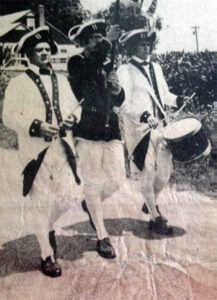 Alt text: Newspaper clipping featuring a Charlestown Colonial Regiment color bearer, fifer, and drummer, highlighting the town’s bicentennial preview and historical military reenactments.
Alt text: Newspaper clipping featuring a Charlestown Colonial Regiment color bearer, fifer, and drummer, highlighting the town’s bicentennial preview and historical military reenactments.
The “Maryland Line,” famed for its valor and heroism during the war, included Ramsay’s 3rd Battalion. In a critical moment at the Battle of Monmouth, General George Washington personally tasked Ramsay with holding back the British assault, a strategic maneuver to allow the Colonial Army to retreat safely. In this courageous stand, the entire 3rd Battalion was either killed or captured, and Ramsay himself became a British prisoner for the remainder of the war. Despite this hardship, Ramsay continued to serve his nation after the war, holding distinguished public service positions, including Maryland Congressional representative (1786-1788), United States Marshal for Maryland, and Officer of the Port of Baltimore.
Charlestown witnessed two significant wartime incidents during the Revolutionary War. The first involved the daring capture and burning of a blockading British warship in Charlestown Harbor, with the ship’s officers and crew paraded through the town’s streets as prisoners. In August 1777, Charlestown endured a bombardment as a diversionary tactic by the British while General Sir William Howe’s troops landed up the Elk River. General Howe’s force of approximately 15,000 troops landed at Head of Elk and marched north, ultimately leading to the Battle of Brandywine, a pivotal engagement in the Revolutionary War.
During the War of 1812, British forces once again entered Charlestown harbor. At this time, the town’s defenses were weak, consisting of a small, deteriorated fort. Faced with the approaching British, most of Charlestown’s residents evacuated to Foy’s Hill, leaving the town largely deserted. British troops searched Charlestown before proceeding to Havre de Grace, where a more significant battle ensued.
More information about this period can be found in the War of 1812 Event document (PDF).
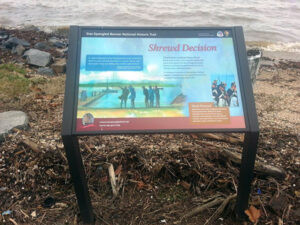 Alt text: A historical marker sign in Charlestown MD, indicating its rich colonial history and preserved heritage as an early American town.
Alt text: A historical marker sign in Charlestown MD, indicating its rich colonial history and preserved heritage as an early American town.
Charlestown experienced a period of decline from 1780 to 1820, primarily due to reduced trade and shipping with the British Empire after the Revolutionary War. A severe hurricane in 1786 played a role in shifting maritime traffic by opening up the Locust Point Channel to Baltimore and establishing Havre de Grace as a more accessible deep-water port. These developments diminished Charlestown’s prominence as a major trading center. The town suffered another blow when its status as county seat was transferred to Elkton, a town located at the head of the Elk River. Disappointed by these changes, many prominent Charlestown residents relocated to Baltimore.
Over time, the combined effects of the Revolutionary War, the realignment of the Old Post Road, improved inland roads diminishing reliance on water transport, and the establishment of Elkton as the new Cecil County Seat in the 1780s, led Charlestown to recede into a state of quiet obscurity. However, this “deep sleep” inadvertently contributed to the preservation of the town’s historic architecture and character, allowing many colonial-era resources to survive into the present day.
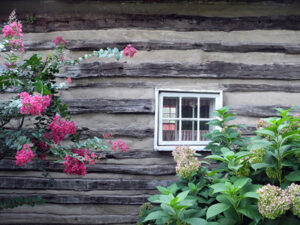 Alt text: A historic street view in Charlestown MD, showcasing preserved colonial buildings and the town’s architectural heritage in its historic district.
Alt text: A historic street view in Charlestown MD, showcasing preserved colonial buildings and the town’s architectural heritage in its historic district.
Charlestown’s escape from rapid modernization has allowed it to retain its heritage. The Historic District, encompassing approximately 150 buildings, stands as a living testament to its past. Many of these structures are historic inns and amenities that once catered to the bustling colonial populace. While some Victorian buildings exist, many structures that appear to be of later origin often reveal much earlier foundations upon closer inspection, their original identities obscured by alterations over the centuries.
Charlestown’s colonial historic sites and structures were primarily functional, reflecting its role as a port and mercantile town. Rather than grand mansions, the town was characterized by smaller working buildings suited for municipal life centered around colonial government and services. Architecturally significant gambrel roof structures, such as the “Red Lyon Tavern,” remain a distinctive feature of Charlestown. Early construction materials included log, stone, and brick, reflecting the available resources and building techniques of the time. Furthermore, the town is surrounded by significant archaeological sites predating colonial settlements and an abundance of sensitive natural resources, adding layers to its historical and environmental significance.
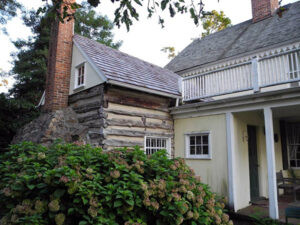 Alt text: A log cabin addition to a historic house in Charlestown MD, demonstrating early American construction techniques and the town’s architectural history.
Alt text: A log cabin addition to a historic house in Charlestown MD, demonstrating early American construction techniques and the town’s architectural history.
Among the notable historic buildings in Charlestown are:
- Cecil Cooper House (CE-395): Dating from the 19th century, this three-story Empire-style house with a slate mansard roof, located at the corner of Louisa Lane and Water Street, was historically a private residence.
- Cecil House Inn/Gamble House (CE-397): Situated at Caroline and Bladen Streets, believed to be on the site of an older structure along the Old Post Road, this Victorian brick house with a pitched gable roof, is recognized as the historic “Cecil House Inn.”
- Cecil Hotel (CE-108; circa 1810): Located at Caroline and Bladen Streets, this two-story Federal-style frame building, once a tavern, retains original features like windows, front door, and a semicircle arched fanlight and is currently undergoing restoration.
- Charlestown Town Hall and Post Office (CE-388): Constructed in 1878 on Market Street, this building served as an elementary school until 1961 and now functions as the town hall and post office.
- County Jail Site/Proposed Courthouse Site (CE-396; circa 1750): Located at Frederick and Calvert Streets, this site, now owned by the Town of Charlestown, was intended for the first Cecil County Jail and Courthouse, though only a small jail was built in the 18th century.
- Eagle Point Gun Club/Mulveny House (CE-389): Dating back to the early 1800s, this house, located on a bluff overlooking the Northeast River and featured in an 1813 sketch of Charlestown, was used by seasonal duck hunters and recently suffered fire damage in June 2024.
- Frame Ice House (CE-1299): Built in 1890 by Perry K. Barnes on Water Street near Veteran’s Park, this ice house constructed of eastern white pine planks and shiplap siding, with a later addition for net storage, stands as a unique example of vernacular architecture. More information is available in the Ice House Dedication document (PDF).
- Hamilton House (CE-107; circa 1755): Originally located on Bladen Street, this frame house with a gambrel roof, built by John Kankey, was relocated to Pennsylvania in the late 20th century.
- Ice House (CE-1304): A small stone structure located on Conestoga Street near the colonial wharf.
- Klondike/McKeown House (CE-109; circa 1900): This ornate Victorian house, possibly influenced by San Francisco architecture, features dark wood paneling and a hexagonal icehouse, built by the McKeown brothers who made their fortune in Nevada gambling.
- Lackey-Murphy House (CE-1301): Located on Baltimore Street, originally built in 1750 with additions in 1865 and 2000, this house has been owned by the Murphy family for over a century.
- Linton House (CE-110; circa 1787): Situated at 316 Market Street, built by Charlestown Commissioner William Linton, this brick house with Flemish bond and a gable roof hosted George Washington on his travels.
- Mary Palmer Tavern (CE-398; circa 1790): A late 18th-century tavern owned by Mary Palmer, a Revolutionary War widow, located near the Old Post Road, featuring a three-story structure with a side hall plan.
- Nathaniel Ramsay/Key-Ramsey House Site (CE-1300): The original home of Francis Key, birthplace of John Ross Key and father of Francis Scott Key, composer of the “Star Spangled Banner,” this site, marked in an 1813 sketch, was a brick house that burned down in 1834 and is now an archaeological site.
- Northerman House (CE-380): Located at 225 Market Street, a two-story frame dwelling built around 1762 by Jacob Northerman, featuring original clapboard beneath later sidings and massive corner fireplaces.
- 107 House (CE-386; circa 1750): Now the Charlestown Museum at 343 Market Street, this structure, possibly “built in the Dutch fashion,” was rebuilt around 1810 and restored by Colonial Charlestown, Incorporated, featuring a restored tavern kitchen in the cellar.
- Paca House (CE-111; circa 1750): Home of John Paca, brother of Governor William Paca, this house at 315 Market Street, originally a frame dwelling, received a gambrel roof stone wing in the late 1700s.
- Post House/Holloway House (CE-384; 18th Century): Recognized as one of Charlestown’s old inns along the Old Post Road (MD Route 267), this frame and log building is a two-story structure.
- Perry Barnes House (CE-387): A Victorian frame house on Market Street, exhibiting ornamental Victorian architecture with a steeply pitched roof.
- Red Lyon Tavern (CE-128; circa 1750): A significant historic site with multiple buildings, featuring wide shiplap siding, a large cellar fireplace, and connections to the French and Indian War, having billeted the Royal American Regiment.
- Samuel McNear House (CE-383): A late 18th-century frame house on Baltimore Street, with a large basement fireplace and cooking crane, now covered in asphalt shingles with rear additions.
- St. John’s Methodist Episcopal Church (CE-379; circa 1856): Located at Market and Bladen Streets, constructed in 1856, distinguished by its geometric patterned stained glass windows.
- Scott Jackson House (CE-1305): Built in 1901 at Bladen and Caroline Streets by craftsman Scott Jackson, featuring chestnut wood trim.
- Shelton House (CE-1303): Constructed in 1872 on Water Street by George Shelton, depicted in the 1877 Cecil County atlas.
- Still House (CE-393; circa 1760): Located on Lot 1 of the original Charles Town plat, a rambling frame structure from 1760, one of Maryland’s early rum distilleries, also featured in the 1813 sketch of Charlestown.
- The Indian Queen Tavern (CE-127; circa 1740): Founded by Zebulon Hollingsworth, this is Charlestown’s most significant historic resource, a two-story frame structure with a central chimney, post and beam construction, and original 18th-century woodwork.
- Thorn House (CE-1298): Situated on Conestoga Street facing the Northeast River, built as a retreat for Pennsylvania Railroad Chief Engineer Christopher Columbus Thorn, a rambling one and half story structure with a slate roof and welcoming demeanor.
- Warehouse Site (CE-390); Customs House Site (CE-391); Charlestown Wharf Site (CE-392); and Charlestown Wharf (CE-1297): Located at Water and Conestoga Streets, dating back to Charlestown’s founding in 1742, including the Charlestown Wharf, Warehouse, and Customs House, vital to Maryland’s colonial commerce, with parts now forming the Charlestown fishing pier.
- Water Tower (CE-1306): Located behind the Charlestown Museum on Market Street, originally built for the McKeown House and later moved, reflecting early carpentry similar to boat building.
- Wellwood Club (CE-394): Situated on Water Street, built in the mid-19th century as a seasonal wildfowl hunting club, ideally located for duck hunting on Chesapeake Bay’s Susquehanna Flats, featuring formal rooms and dormitory-style bedrooms.
Charlestown also encompasses historic cemeteries and public spaces known as “commons.” While some significant colonial structures depicted in “Latrobe’s View of Charlestown” from 1813, such as the Market House and various residences, have been lost over time, the town retains a remarkable collection of historic buildings.
 Alt text: A collage of historic doorways in Charlestown MD, illustrating the diverse architectural details and preserved entrances of colonial-era buildings.
Alt text: A collage of historic doorways in Charlestown MD, illustrating the diverse architectural details and preserved entrances of colonial-era buildings.
A two-room schoolhouse, constructed in 1878, served grades one through six until 1961. This building now serves as the Town Hall and Post Office, proudly displaying the original schoolroom blackboard with carvings of initials and dates, connecting the present to Charlestown’s educational past.
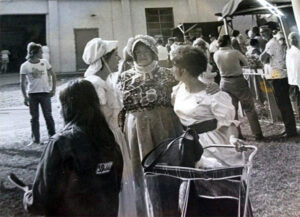 Alt text: A colonial fair event in Charlestown MD, showcasing historical reenactments and community engagement with the town’s colonial heritage.
Alt text: A colonial fair event in Charlestown MD, showcasing historical reenactments and community engagement with the town’s colonial heritage.
While the original mid-18th-century wharf is no longer extant, Charlestown has reconstructed a wharf at the end of a stone pier built over the archaeological remains of the original cribbing. This wharf serves as a tangible reminder of Charlestown’s historical role in Maryland’s commercial history and its close relationship with the North East River.
Today, Charlestown remains a small, water-oriented town with a population of approximately 1,500 residents. It boasts four marinas, a general store, two restaurants, an elementary school, and a Post Office, maintaining a tranquil, river community atmosphere cherished by its inhabitants. The Wellwood Club and the historic buildings lining Water Street in Charlestown, MD are integral parts of this charming town, inviting visitors to step back in time and experience the enduring legacy of colonial Maryland.
